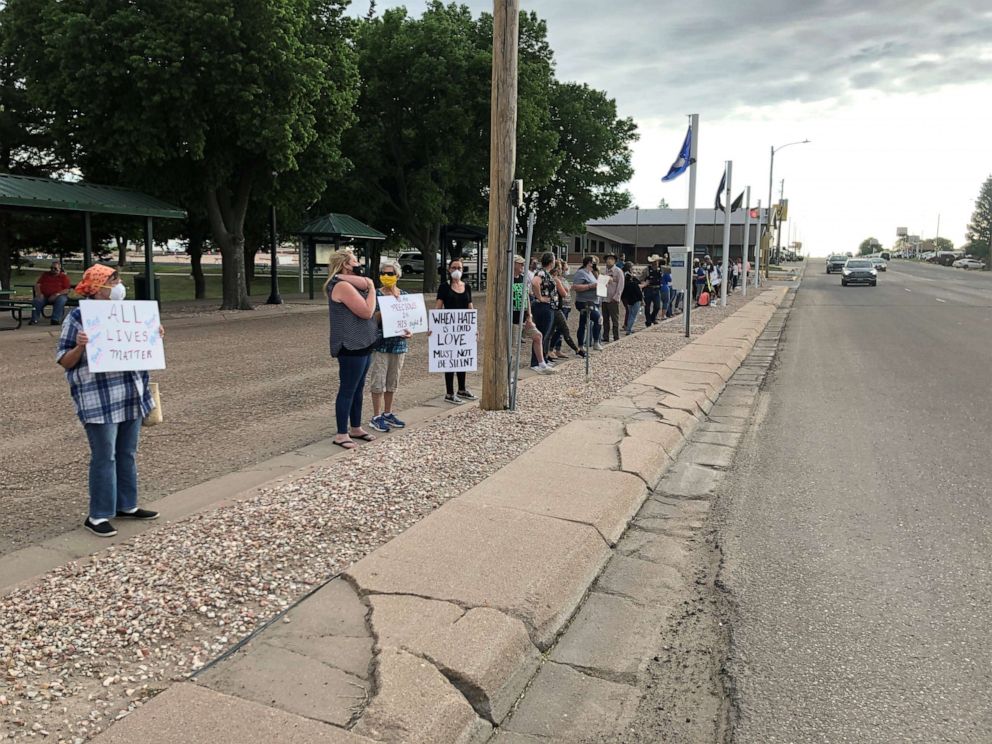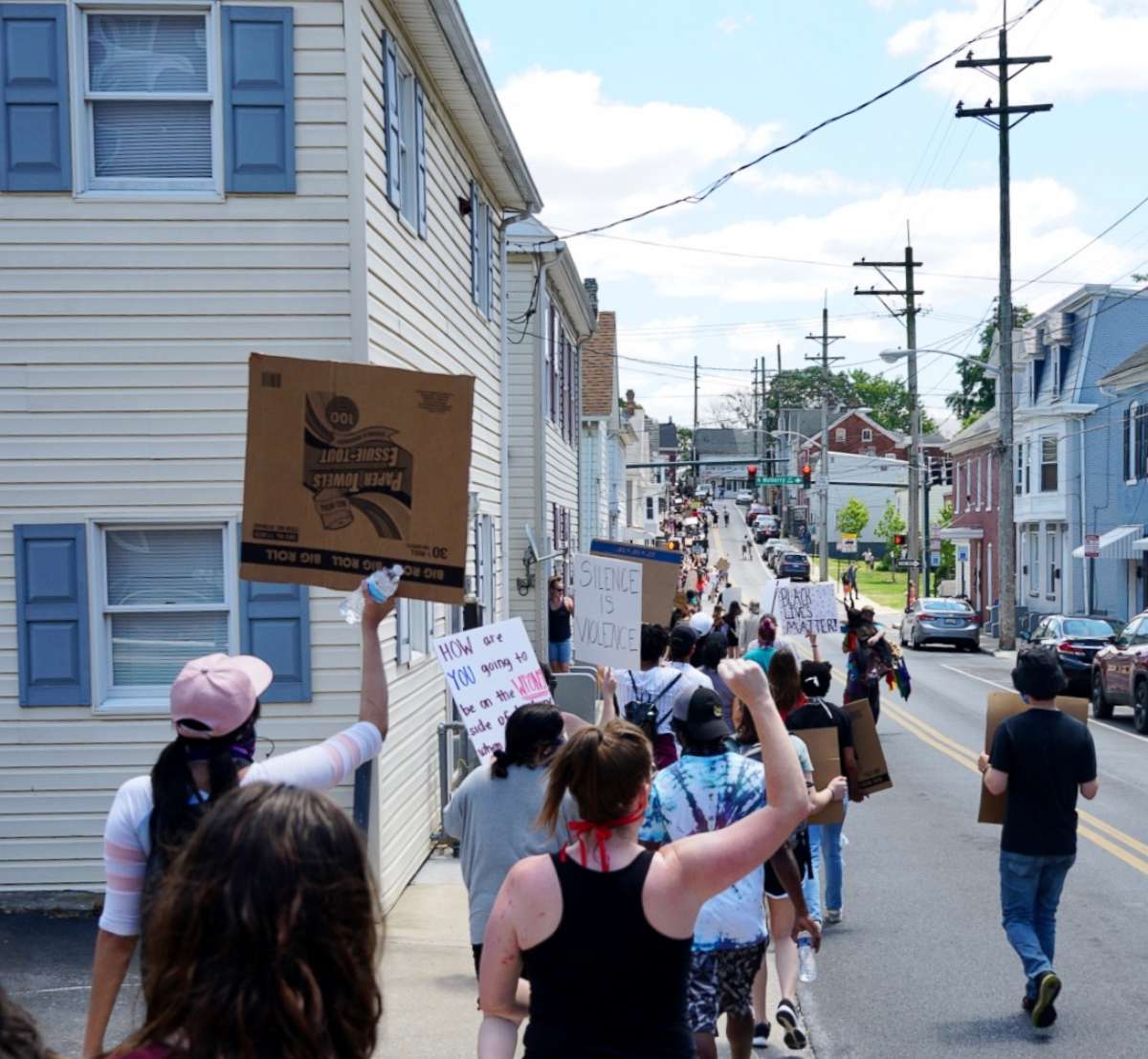George Floyd's death awakens activism in rural, white America
Uncomfortable conversations have moved to front-and-center in small towns.
YUMA, Colorado -- Two hours east of the unrest in Denver following the death of George Floyd, a newspaper editor and police chief heard rumors of buses, full of protesters from as far as Chicago, heading toward their farming community of Yuma after the town's pastor planned a road-side vigil in early June. Local businesses, and even the hospital, closed their doors in response. Some residents threatened to arm themselves with shotguns to protect the town from potential rioters. The town of about 3,500 people is less than 1% black.
"You know public displays like this are going to bring the rioters here," Stephanie Generoux wrote on a Facebook post from the Yuma Pioneer.
"Just so you’re all aware a hitchhiker earlier today in the southern part of the County trying to get to Yuma. Hope you are all ready for what you’re bringing" commented Rich Schafer.
In reality, about sixty locals arrived and stood silently, spaced apart, holding signs. No buses. No violence. Tony Rayl, editor of the Yuma Pioneer, said he knew almost everyone there and called it the most bizarre day of his life. The pastor of a local church said just the existence of the event polarized her congregation.

Savannah Neb, a white recent college graduate living in Yuma who protested that day, described the conversations she had with concerned friends.
"It was completely peaceful, but that that fear that you're feeling, that you felt the last day, is how the black community feels daily in this country."
Less anonymity than the larger urban areas like New York, Seattle or Atlanta is a reality for protesters in these small towns and the wave of Black Lives Matters support has split some conservative, mostly white areas where some believe police brutality and racism is not their problem.
Well attended protests have occurred in small American towns like Alpine, TX, Lodi, CA, Hagerstown, MD and Taylorville, IL. The name George Floyd is echoing through the consciousness of white America, putting uncomfortable conversations front-and-center.
The subject of racism and anti-racism has shown little sign of slowing down. Even weeks after Floyd's death, a small protest popped up in Parachute, a Colorado town of 1,100 people on the Western Slope of the Rocky Mountains. Twenty people, mostly, if not all, white, gathered outside the police station with signs, candles and words of support for Black Lives Matter. Nearly all five of the town's police officers observed, offering water to the protesters.

"It's important to say that this is not just an issue in big cities just because there's more people," said Joanne Gibson, who led the demonstration in Parachute. "It's an issue here. There's systemic racism in all parts of our country. You can't find a place in America that isn't built on a foundation of racism."
Claire Graff lives in Glenwood Springs, Colorado. and has started organizing weekly protests.
"Not living in a city especially and living in my very white, privileged world that I live in, it wasn't in my face and I didn't seek it out enough," she told ABC News. "But now with this momentum, I don't know how I couldn't be part of the voice in our community, and everywhere."
Dawn Dexter, another demonstrator in Glenwood Springs, said she was met with expressions of shock when protesting. "Some people came out of the restaurants and encouraged us. Others just looked ... I'm going to say there were expressions of consternation."

It is in part that attitude in these largely white and homogenous towns making it hard for its black residents to feel part of the community and find allies. Elizabeth Cobbins, who is black and an employee at Western Colorado University in Gunnison, acknowledged it was difficult to find a group to belong to when she moved from Mississippi to the nineteenth-century mining-turned-college town in southwest Colorado.
After the death of George Floyd prompted massive protests across the country, Cobbins said she was committed to leading that charge in her new home. She organized what she thought would be a demonstration of 20-50 of her friends and their friends. What happened was a crowd of more than three hundred flooded Gunnison's Main Street.
"There's one point, I stopped and I just looked back and I could not hold back the tears, like I could not stop them," Cobbins said. "There's so many people in this town who care about my life."
She described a sense of optimism for the movement, but stressed that there's work to be done and the conversation among white people on anti-racism and police brutality needs ongoing leadership to avoid its momentum dying down. Black persons like herself have to live through systemic racism everyday, she says, and will take notice of those speaking up for the first time today are quiet weeks or months from now, whether they live in New York City or Gunnison.
Cobbins said she was proud to go home to her family shortly after the protests and describe the work in a place quite different from Hattiesburg, Mississippi.
"I moved to Colorado for a job but my purpose there was bigger, so I led a protest. You know being a black woman in a mostly white town, it was my purpose to lead this protest, you know I had to do it for my students," she said, telling ABC News about a conversation with her father.
"Hey Dad, I fought for, I fought for my people, in this super white town, my black self," she recounted. "My super pro-Black, Southern gal sitting in the middle of Main Street and I did it for Medgar Evers. I did it for my mother. I did it for Rosa Parks. You know I did it for any Fannie Lou Hammer who said, 'I'm sick and tired of being sick and tired.' I did it for them. And they have the sweetest smile on their face of pride."




